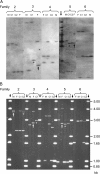Comparison of germ line minisatellite mutation detection at the CEB1 locus by Southern blotting and PCR amplification
- PMID: 20228094
- PMCID: PMC2893306
- DOI: 10.1093/mutage/geq011
Comparison of germ line minisatellite mutation detection at the CEB1 locus by Southern blotting and PCR amplification
Abstract
Identification of de novo minisatellite mutations in the offspring of parents exposed to mutagenic agents offers a potentially sensitive measure of germ line genetic events induced by ionizing radiation and genotoxic chemicals. Germ line minisatellite mutations (GMM) are usually detected by hybridizing Southern blots of unamplified size-fractionated genomic DNA with minisatellite probes. However, this consumes a relatively large amount of DNA, requires several steps and may lack sensitivity. We have developed a polymerase chain reaction (PCR)-based GMM assay, which we applied to the hypermutable minisatellite, CEB1. Here, we compare the sensitivity and specificity of this assay with the conventional Southern hybridization method using DNA from 10 spouse pairs, one parent of each pair being a survivor of cancer in childhood, and their 20 offspring. We report that both methods have similar specificity but that the PCR method uses 250 times less DNA, has fewer steps and is better at detecting GMM with single repeats provided that specific guidelines for allele sizing are followed. The PCR GMM method is easier to apply to families where the amount of offspring DNA sample is limited.
Figures

Similar articles
-
Somatic versus germline mutation processes at minisatellite CEB1 (D2S90) in humans and transgenic mice.Genomics. 2000 Apr 15;65(2):95-103. doi: 10.1006/geno.2000.6161. Genomics. 2000. PMID: 10783256
-
New germline mutations in the hypervariable minisatellite CEB1 in the parents of children with leukaemia.Br J Cancer. 2007 Apr 23;96(8):1265-71. doi: 10.1038/sj.bjc.6603706. Epub 2007 Mar 27. Br J Cancer. 2007. PMID: 17387343 Free PMC article.
-
Paternal lifestyle as a potential source of germline mutations transmitted to offspring.FASEB J. 2013 Jul;27(7):2873-9. doi: 10.1096/fj.13-227694. Epub 2013 Mar 28. FASEB J. 2013. PMID: 23538710 Free PMC article.
-
[Radiation and mutation induction in the human germline].Radiats Biol Radioecol. 2006 Sep-Oct;46(5):537-46. Radiats Biol Radioecol. 2006. PMID: 17133720 Review. Russian.
-
Ionising radiation and mutation induction at mouse minisatellite loci. The story of the two generations.Mutat Res. 2002 Feb 20;499(2):143-50. doi: 10.1016/s0027-5107(01)00284-6. Mutat Res. 2002. PMID: 11827707 Review.
Cited by
-
Rhodiola rosea suppresses thymus T-lymphocyte apoptosis by downregulating tumor necrosis factor-α-induced protein 8-like-2 in septic rats.Int J Mol Med. 2015 Aug;36(2):386-98. doi: 10.3892/ijmm.2015.2241. Epub 2015 Jun 10. Int J Mol Med. 2015. PMID: 26063084 Free PMC article.
References
-
- Sankaranaryanan K, Wassom JS. Reflections on the impact of advances in the assessment of genetic risks of exposure to ionizing radiation on international radiation protection recommendations between the mid-1950s and the present. Mutat. Res. 2008;658:1–27. - PubMed
-
- Shelby MD. Human germ cell mutagens. Environ. Mol. Mutagen. 1994;23(Suppl. 24):30–34. - PubMed
-
- Olshan AF. Lessons learned from epidemiologic studies of environmental exposure and genetic disease. Environ. Mol. Mutagen. 1995;25(Suppl. 26):74–80. - PubMed

